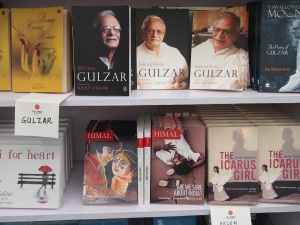
I kicked off day three of the JLF, my second, with a well-attended but not oppressively crowded session called ‘Beauty and Fidelity: Texts in Translation’, featuring a Chinese-English translator (Carlos Rojas), a Hindi author (Geetanjali Shree), her English translator (Rahul Soni–also Asymptote literary journal’s India editor-at-large), a Marathi author (Sachin Kundalkar) and his English translator (Jerry Pinto). The pairing of the authors with their translators made for fruitful discussion, as did the addition of somewhat of a wildcard, Carlos Rojas.
The panel immediately discarded the topic, which summarised that old adage of translation (“that translations are like women: either beautiful, or faithful”) and, as Jerry Pinto stated, is both offensive to translators and to women. Having not heard of Marathi-language author Sachin Kundalkar, I was enticed into buying the English translation of his novel Cobalt Blue by the wit that both he and his translator, Pinto, displayed. A favourite anecdote of mine was when Kundalkar told how the Marathi and English versions of the novel have reached different audiences. The young weren’t drawn to the Marathi version, but he now gets messages from youngsters saying how much they enjoyed his book and look forward to the Marathi translation!
The second session of day 3, ‘Dispensable Nation: Afghanistan after the US Withdrawal’ (with a panel of scholars, writers and journalists specialising in Afghanistan, and moderated by William Dalrymple) was so crowded that I was sat on the ground a metre from the stage. Despite the fact that I could only see Dalrymple’s face and could barely make out any voices because of my awkward proximity to the side of the speakers, I would have endured the full session had there not been a freezing cold, foggy wind. So I went book shopping instead. Several others I spoke to after the session were disappointed that William Dalrymple tended to dominate the discussion with his war-horse stories of Afghanistan.
Being a huge fan of Urvashi Butalia, I attended her session ‘Savage Harvest’ with Navtej Sarna, the son of an eminent Punjabi author who wrote about Partition. Translation was once again pointed to as a necessary way of disseminating forgotten or ignored experiences, and the fact that Partition literature can still be discussed in such terms six and a half decades after the event shows how much more needs to be done.
In the afternoon I attended the parallel event that was being hosted this year: Bookmark, held at the nearby Narain Niwas, an effort to get publishing professionals together to talk about challenges and opportunities that the industry faces. By all appearances it was a small event this year, and attended mainly by small publishers, but the event is something that the JLF organisers will be trying to develop in future years. The discussions–from Indian and international publishers, editors, book-sellers, and so on–were more specialised and industry-focused than many of those held at the Diggi Palace, but for people with any interest in the industry it was a welcome opportunity to interact with other professionals. And the calm of the Narain Niwas grounds was more than welcome.




